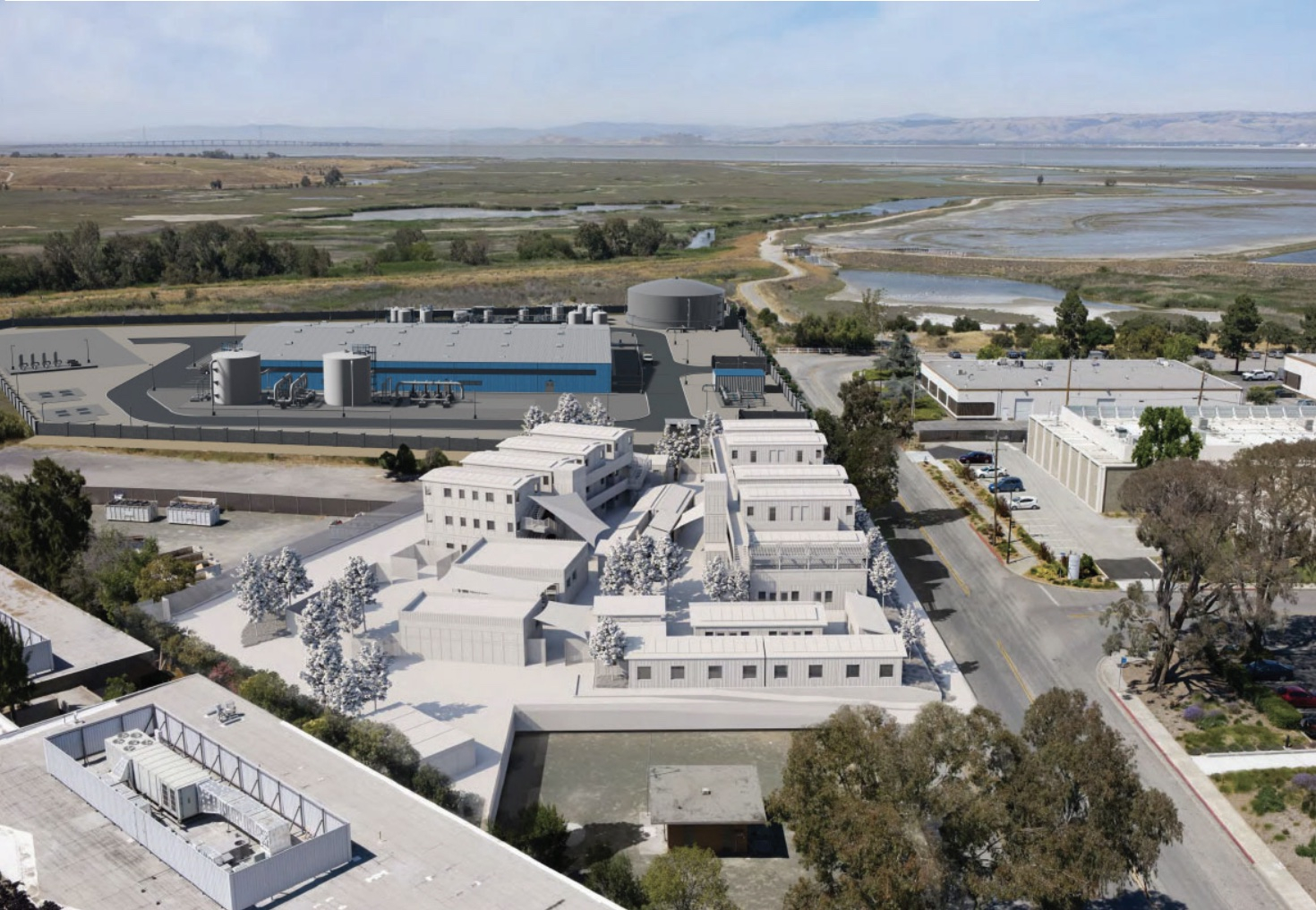Days after Palo Alto officials broke ground on a "transitional housing" complex for homeless residents, they received an application for a very different type of development at an adjacent site in the Baylands: an industrial plant that will turn wastewater into potable water.
The Santa Clara Valley Water District, commonly known as Valley Water, submitted on Nov. 7 its application for a sprawling advanced purification plant at 1237 San Antonio Road, near the Mountain View border. Once constructed, the plant will purify wastewater from the existing wastewater plant on Embarcadero Road and then send it south.
The new plant will stand next to the 88-apartment complex for unhoused individuals that is now being constructed. Spearheaded by the nonprofit organization LifeMoves, the development will house about 100 individuals at any given time, with estimated stays of about six months. The city held an official ground-breaking ceremony for the housing project on Oct. 31.
Both projects have been years in the making. The water purification plan is key component of an agreement that the city and Valley Water signed in 2019. The deal allows the water agency to pursue its purification plant at the San Antonio Road site and, if requested, sell some of the treated water to Palo Alto. In exchange for the development rights, Valley Water is contributing $16 million toward construction of a salt-removal facility near the existing Regional Water Quality Control Plant on Embarcadero Road — a plant that will allow Palo Alto to make more recycled water available for irrigation.
Valley Water's application cites climate change and the frequency of droughts as the main drivers for the new water plant on San Antonio. The development will include an advanced purification facility, which turns treated wastewater into potable water, a pump station and three miles of pipelines, including a line connecting the new plant with the existing Regional Water Quality Control Plant at 2500 Embarcadero Road.
The application states that the project will "advance treat" wastewater effluent from the Embarcadero Road plant and then "convey that water 20 miles south through Santa Clara County to replenish Valley Water groundwater basins located in the Los Gatos Recharge System Complex in the city of Campbell."
Kirsten Struve, assistant officer for the water supply division at Valley Water, said at a June 5 public hearing on the project that the project's key goal is developing a "drought-proof locally controlled supply."
"In addition, the project protects our groundwater and helps prevent the land from sinking, as it did prior to Valley Water's management," Struve said at the meeting.
Plans for the project show a sprawling complex with a 26-foot-tall building at the center and various smaller structures at the periphery, including eight chemical tanks at the north end, two transfer pumps in the south and a 35-foot-tall clear well on the northwest corner for storing the purified water.
The Palo Alto City Council reaffirmed its support for the new plant at the June hearing, where it agreed to change the land designation of the Baylands site to "public facility" so that it could be used for an industrial operation. While council member Pat Burt expressed some reservations about the fact that most of the treated water would go to communities outside Palo Alto, the council generally agreed that the project merits support, particularly given that the site has a history of being used for wastewater treatment.
Council member Vicki Veenker noted that Valley Water's proposed development would be consistent with the council's vision for the San Antonio site, to "enhance the natural state."
"Currently, we have a use on that site that doesn't feel like it's in keeping with that purpose to enhance the natural state," Veenker said. "In some ways this new use would be because it might help us clean up the contamination and conserve one of our most precious natural resources, which is water."



Comments
Registered user
Rengstorff Park
on Nov 10, 2023 at 8:54 pm
Registered user
on Nov 10, 2023 at 8:54 pm
A wastewater treatment plant will "enhance the natural state" of the Baylands?
Registered user
Cuesta Park
on Nov 13, 2023 at 2:26 pm
Registered user
on Nov 13, 2023 at 2:26 pm
Especially 'case this is very near the site (I think) that the MV Shoreline Community District/ MV City Council wanted to reserve for a North of 101 elementary school site/ MVWSD Trustees 'howling' about that idea. Good 4 them.
More recycled water / for MV ? good for MV.
Registered user
another community
on Nov 14, 2023 at 12:05 pm
Registered user
on Nov 14, 2023 at 12:05 pm
The production of secondary sewer water in Palo Alto is already spread around to Stanford, Palo Alto and Mountain View for use in landscape irrigation. Some is already injected into the ground to replenish the local aquifer but that aquifer is doing well already. The remainder has to be discharged into the Bay.
This plan takes that water and pumps it miles to existing percolation ponds that replenish a different aquifer where Valley Water already replenishes it using its share of water from the state water project. The district also uses state supplied water to provide to customer water services via direct connections. The water the state currently puts onto ponds does not need to be purified by the percolation process.
The thing is though, that the Sunnyvale water treatment plant is closer and it also has secondary sewage treatment water available. They never explain why the shorter pipeline distance doesn't cause them to select Sunnyvale as the new source for the percolation ponds.